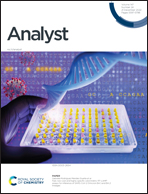Au nanoclusters-decorated WO3 nanorods for ultrasensitive photoelectrochemical sensing of Hg2+†
Abstract
Photosensitizers and enzyme mimics are extensively used in photoelectrochemical (PEC) sensing, but few materials can be used as both photosensitizers and enzyme mimics in PEC sensing. Herein, we report Au nanoclusters (AuNCs) as both photosensitizers and peroxidase mimics for sensitive PEC sensing of Hg2+. It is found that AuNCs can act as photosensitizers to improve the PEC activity of WO3 nanorods; so the WO3/AuNCs composite material can be used as an advanced photosensitive material for PEC detection. AuNCs can also catalyze precipitate formation on the photoelectrode because of their peroxidase mimetic activity, and the interface electron transfer is hindered by the formed precipitate. Thus, the photocurrent of the WO3/AuNCs-based photoelectrode is quenched. When Hg2+ is present, the AuNCs-catalyzed precipitate formation is inhibited by Hg2+ because of the binding of Hg2+ to AuNCs through Hg2+–Au+ interactions. The photocurrent of the WO3/AuNCs-based photoelectrode increases accordingly, enabling “signal on” PEC detection of Hg2+. A broad linear range for Hg2+ detection is achieved between 1.0 pM and 50 nM with a detection limit of 0.2 pM. We have developed an advanced photosensitive material and introduced a simple method for PEC detection of Hg2+.



 Please wait while we load your content...
Please wait while we load your content...